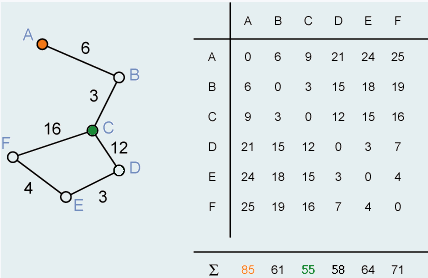|
|
Accessibility of vertices and places
A frequent type of analysis in transport networks is the investigation of the accessibility of certain traffic
nodes and the developed areas around them. A measure of accessibility can be determined by the method shown in the
animation. The accessibility of a vertex i is calculated by:
where v = the number of vertices in the network and n
(i, j) = the shortest node distance
(i.e. number of nodes along a path) between vertex i and vertex
j. Therefore, for each node i the sum of all the shortest node distances
n(i, j)
are calculated, which can efficiently be done with a matrix. The node distance between two nodes i
and j is the number of intermediate nodes. For every node the sum is formed.
The higher the sum (node A), the lower the accessibility and the lower the sum (node C), the better the
accessibility.
The importance of the node distance lies in the fact that nodes may also be transfer stations, transfer points for goods, or subway stations. Therefore, a large node distance hinders travel through the network.
 Calculation of the accessibility Ei
Calculation of the accessibility EiAs with the diameter of a network, a weighted edge distance can also be used along with the pure topological node
distance. Examples of possible weighting factors are: distance in miles or travel time as well as transportation cost.
For this weighted measure, however, the edge distance is used and not the node distance.
where e is the number of edges and s(i,
j) the shortest weighted path between two nodes.
